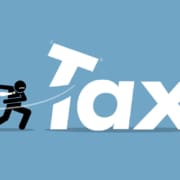Almost everyone who has sold a home has heard that the sale is non-taxable. While this is true for many homeowners, there are rules and reporting requirements. Knowing these can reduce the amount of tax you pay and ward off a letter from the IRS.
Sale of Home Exclusion
The IRS allows for an exclusion of capital gains (profit) on the sale of your primary residence of up to $250,000 for those filing Single on their tax returns, and up to $500,000 for those filling Married Filing Jointly (MFJ). This can save taxpayers a large amount of taxes.
Basic Gain Formula
There are three parts to the formula: proceeds, basis, and gain. The amount you originally paid for the home is the basis. The amount you sold the home for is the proceeds. Gain is the difference between the two, or how much profit you made.
Proceeds – Basis = Gain
Example: Gain Formula
Mary bought a house for $300,000, and sold it 10 years later for 700,000. Using the
formula, her gain (before exclusion) is $400,000.
$700,000 – $300,000 = $400,000
Sale of Home Exclusion Rules
For the most part, the exclusion rules are relatively straight forward. There are exceptions, notably if the home has been used as a rental, so be sure to talk to your tax preparer. But in general, to qualify homeowners must:
- Own and live in their home as their primary residence for two of the last five years before the sale.
- The ownership and residence requirements do not have to be met concurrently.
- Not have sold another primary residence and excluded the gain within the last two years before the current sale.
Example: Married Filing Jointly
Jack and Jill bought their home in 2015 for $300,000, and have lived in it as their primary residence up until they sold it for $700,000 during 2020, and file their taxes using the MFJ status. Their gain is $400,000, but because it is under the $500,000
MFJ exclusion cap, they owe no taxes on the sale.
Example: Not living in the home at the same time it is owned
Bill and Barbara, who file MFJ, rented a home to live in during 2016, and purchased it from the owners in 2018 for $300,000. However, after they bought the home they moved out, and allowed their son to live there (rent free) from 2018-2020 while attending college. When he graduated in 2020, they sold it for $800,000.
In this example, the couple did not live in the house during the time they owned it. Their son living there does not make it their primary residence during that time. However, they lived in the home two of the past five years, and owned it for two of the last five years. Despite the fact that they did not live in the home while they owned it, they qualify for the full $500,000, making none of the gain taxable.
Gain Above Exclusion
But what if you made more than the exclusion? Is there anything you can do?
If the gain is more than your exclusion, or you don’t qualify for the exclusion, there are additional steps you can take to raise your basis or lower the proceeds, making less, or all, of the gain non-taxable.
Raising Basis
Many homeowners make improvements to their home while they live there. The IRS allows you to add amounts to your basis that were paid for substantial physical improvements that: materially adds to the value of your home, significantly prolongs its useful life, or adapts it to new uses.
Qualifying improvements include:
- New windows, doors, or roof
- New wall-to-wall carpeting or other permanent flooring
- Installing new insulation, pipes, duct-work
- Building an addition such as a bedroom, bathroom, office, or garage
- Replacing driveways or walkways
- Installing a new or upgraded heating or air conditioning system
- Installing new built-in appliances
- Installing new fences, retaining walls, porches, patios, or decks
- Installing extensive new landscaping, such as a new lawn
- Items that do not qualify include:
- Repairs – roof, cracks in driveway, appliances
- Maintenance – painting walls, cleaning carpets
Example: Raising basis
Jacqueline bought a house for $500,000 in 2010 and sold it in 2020 for $1,000,000, resulting in a gain of $500,000. She qualifies for the $250,000 exclusion for taxpayers who file single, leaving $250,000 taxable gain. However, while she owned the property, she completely remodeled the kitchen for $40,000, added a home office to the house for $50,000, and installed new energy efficient windows for $20,000 (she did not take a tax credit for the windows). All of these items qualify to be added to her basis. After adding these items, her adjusted basis is $610,000, and taxable gain is $140,000
Original basis $ 500,000
Kitchen + $ 40,000
Home Office + $ 50,000
Windows + $ 20,000
Adjusted basis =$610,000
Proceeds $1,000,000
Adjusted basis – $ 610,000
Exclusion- $ 250,000
Taxable Gain =$ 140,000
By increasing the basis, Jacqueline will pay taxes on $140,000 instead of $250,000, a $110,000 difference. Much better, but there is more that can be done.
Reducing Proceeds
The IRS also allows you to reduce the proceeds by expenses typically incurred by the seller. Qualifying expenses cannot physically affect the property, and may include:
- Advertising
- Appraisal fees
- Attorney fees
- Closing costs
- Document preparation fees
- Escrow fees
- Notary fees
- Real estate broker’s commission
- Settlement fees
- Title search fees
Example: Reducing Proceeds
Let’s go back to Jacqueline. She sold the house for $1,000,000, but incurred substantial expenses while selling. She paid commissions of $60,000 (6%) to the real estate brokers, and another $30,000 in attorney fees, closing costs, escrow, and other qualifying fees.
When subtracted from the original proceeds, the adjusted proceeds are now $910,000 and, using the adjusted basis of $610,000 from the Raising Basis section above, and her Sale of Home Exclusion, her taxable gain is $50,000 (illustrated below).
Proceeds $1,000,000
Commission – $ 60,000
Other costs – $ 30,000
Adjusted proceeds =$ 910,000
Adjusted proceeds $ 910,000
Adjusted basis – $ 610,000
Exclusion – $ 250,000
Taxable Gain =$ 50,000
While not zero, taxes on $50,000 will be much lower than on the original $250,000 gain that would have been taxable if we’d just used the original proceeds ($500,000) and basis ($250,000).
Reporting Requirements
Even if none of the gain ends up being taxable, you may be required to report it to the IRS. This will be done on both IRS Forms 8949 and Schedule D (Sch D) on your tax return.
You must report the sale when:
- The sales price is over $500,000. The title company is required to issue you a form 1099-S, Proceeds from Real Estate Transactions, at the beginning of the next year. They must also file this form with the IRS. Not reporting these transactions on your return will cause the IRS computers to automatically send you a letter stating that you owe tax on all of the original proceeds from the sale.
- There is any taxable gain after the exclusion is taken. This is determined by the using the original proceeds and basis, not the adjusted. If this calculation shows a gain, you must report the transaction, even if there is no taxable gain after all adjustments are made.
- You choose not to take the exclusion – there are a number of reasons to not take the exclusion. Talk with your tax professional about whether this action is right for you.
What to Watch Out For
Tax preparation software, both those used by DIYers and tax professionals, have steps used to calculate whether the gain is taxable. The problem is that if the sale is over $500,000 but is not taxable according to the software’s calculations, it may generate a worksheet showing the calculations, but not automatically carry the information to the 8949 or Sch D. In most cases, the IRS does not receive the worksheet when the return is filed. There are steps within the software that will correct this, but may not be intuitive.
You Received a Letter from the IRS
In the event that you do receive a letter due to incorrect reporting, it’s not the end of the world, but it can be a hassle. A response will need to be prepared showing the correct basis, proceeds, and gain. It’s then mailed to the IRS, and you wait for it to be processed. Unlike the automatic letter you received, the response is processed by a human, and takes time. Factor in delays due to due to unforeseen circumstances (Covid, new laws, government shutdowns), and it can take months before you receive a response. During 2020, turnaround was taking roughly 10 months.
Save yourself the hassle; make sure the sale is reported on the correct forms before the return is e-filed.
Conclusion
The Sale of Home Exclusion is a useful, legal way to reduce the amount of taxes paid on the profits earned on the sale of your personal residence. The rules are relatively straightforward, and reporting is not onerous, although it’s important to make sure that the transaction is reported correctly.
Megan Austin, EA
Treu Accounting
720-730-4838
megan@treuaccounting.com
www.treuaccounting.com








